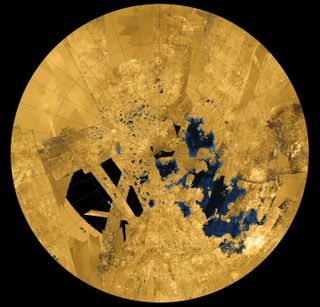Total Volume of Saturn Moon Titan's Otherworldly Seas Calculated

The lakes and seas on Saturn's largest moon Titan hold massive amounts of liquid hydrocarbons — 40 times more than are found in Earth's proven oil reserves, new observations by NASA's Cassini spacecraft suggest.
Titan, which is about 1.5 times bigger than Earth's moon, harbors about 2,000 cubic miles (9,000 cubic kilometers) of liquid methane and ethane on its frigid surface, researchers announced last week. The hydrocarbons are almost all contained in an area near Titan's north pole that's just 660,000 square miles (1.62 million kilometers) in size, a region slightly larger than Alaska.
The find indicates there is something favorable in the geology that restricts most liquid to Titan's northern hemisphere, researchers said. The prime suspect is regional extension of the moon's crust, a process that on Earth created fault lines with depressions and mountain ranges parallel to each other. [Tour Titan's Hydrocarbon Seas (Video)]
"We think it may be something like the formation of the prehistoric lake called Lake Lahontan near Lake Tahoe in Nevada and California, where deformation of the crust created fissures that could be filled up with liquid," Randolph Kirk, a Cassini radar team member at the U.S. Geological Survey in Flagstaff, Ariz., said in a statement issued by NASA last week.
Titan is often pegged as a prime location to understand more about Earth, especially because it is the only solar system body other than our planet known to have stable liquid on its surface. Titan is also large — it's bigger than Mercury — and has active weather, including possible cyclones.
Newly released radar data from Cassini also measured the depth of Ligeia Mare, a first for any lake or sea on Titan. Ligeia, Titan's second-largest sea, is made up of methane, scientists said, and is about 560 feet (170 meters) deep, making at least part of it deeper than the average found in Lake Michigan.
"This was possible partly because the liquid turned out to be very pure, allowing the radar signal to pass through it easily. The liquid surface may be as smooth as the paint on our cars, and it is very clear to radar eyes," NASA officials wrote in a press release about the discovery.
Get the Space.com Newsletter
Breaking space news, the latest updates on rocket launches, skywatching events and more!
NASA also released a new photomosaic of Cassini images showing the bodies of liquid hydrocarbon in Titan's northern hemisphere.
The $3.2 billion Cassini mission launched in 1997 and has been orbiting Saturn since 2004. In recent months, scientists noted several changes as summer approaches in the northern hemisphere of Titan, such as a surprising rise in the moon's atmosphere.
Follow Elizabeth Howell @howellspace, or SPACE.com @Spacedotcom. We're also on Facebookand Google+. Original article on SPACE.com.
Join our Space Forums to keep talking space on the latest missions, night sky and more! And if you have a news tip, correction or comment, let us know at: community@space.com.

Elizabeth Howell (she/her), Ph.D., is a staff writer in the spaceflight channel since 2022 covering diversity, education and gaming as well. She was contributing writer for Space.com for 10 years before joining full-time. Elizabeth's reporting includes multiple exclusives with the White House and Office of the Vice-President of the United States, an exclusive conversation with aspiring space tourist (and NSYNC bassist) Lance Bass, speaking several times with the International Space Station, witnessing five human spaceflight launches on two continents, flying parabolic, working inside a spacesuit, and participating in a simulated Mars mission. Her latest book, "Why Am I Taller?", is co-written with astronaut Dave Williams. Elizabeth holds a Ph.D. and M.Sc. in Space Studies from the University of North Dakota, a Bachelor of Journalism from Canada's Carleton University and a Bachelor of History from Canada's Athabasca University. Elizabeth is also a post-secondary instructor in communications and science at several institutions since 2015; her experience includes developing and teaching an astronomy course at Canada's Algonquin College (with Indigenous content as well) to more than 1,000 students since 2020. Elizabeth first got interested in space after watching the movie Apollo 13 in 1996, and still wants to be an astronaut someday. Mastodon: https://qoto.org/@howellspace
